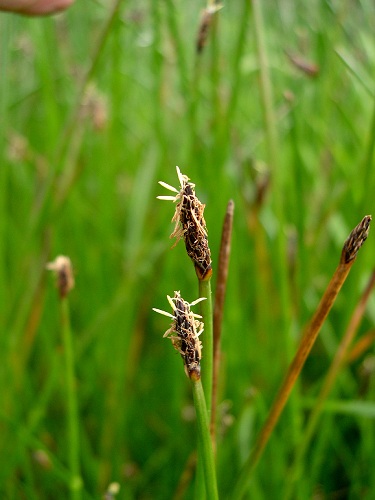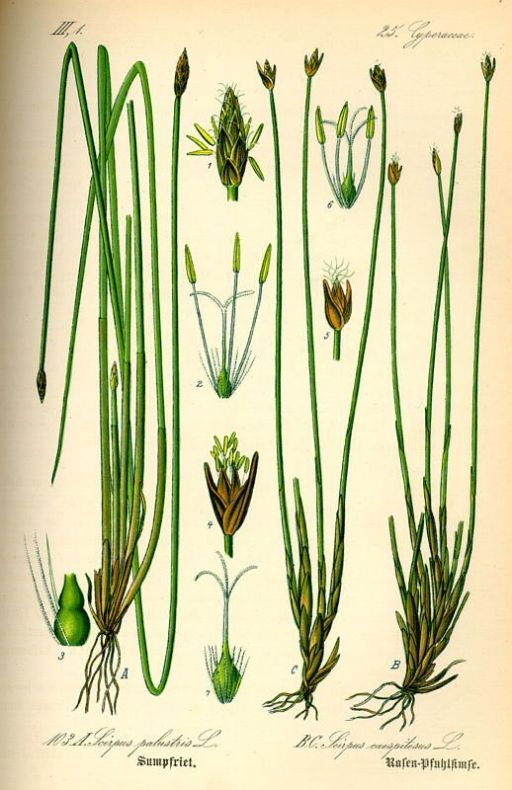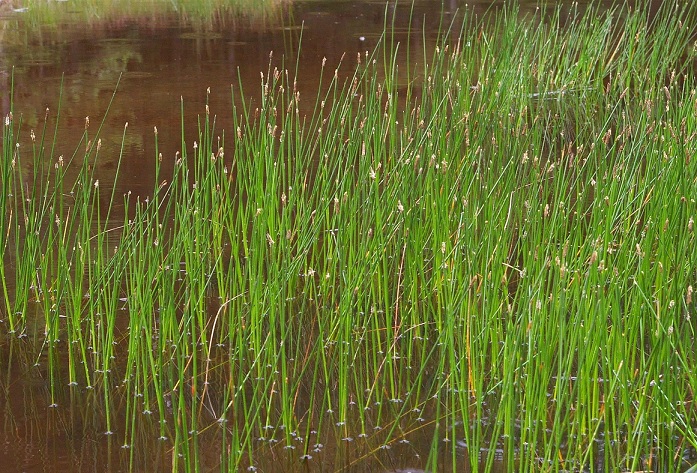|
|
|
Hansen's Northwest Native Plant Database |
|
|
|
Eleocharis palustris or Eleocharis macrostachyas(Common Spike Rush, Creeping Spike-Rush)
Photo at right from Gordon Leppig and Andrea J. Pickart |
 |
||||||||||||||||||||||||||||||
| The Eleocharis family can be distinguished from other sedges by the presence of a tubercle (a small bump, like a nipple) on the achene (or fruit) and the fact that the stems grow in groups and are usually tufted. This particular species is further distinct in that four bristles surround the achene. Eleocharis derives from the Greek words heleios (marsh) and charis (joy, beauty or grace). Hence the name means marsh beauty. | |||||||||||||||||||||||||||||||
|
Common Spike Rush is found in abundance along the Pacific Northwest coastline and elsewhere throughout the world. The striated, ½ to 3 tall stems are oval and grow from dark, vigorous rhizomes. The leaves are present only as sheaths, and are reddish colored at the base. Flowers are hermaphroditic and clustered in a single, erect spike at the end of the stem. They are oval and range in length up to 1 and bloom from June to late August. The fruit are tiny, yellowish brown and have a tubercle and four bristles. The seeds, found inside the fruit, are extremely long-lived and will sprout in waterlogged conditions. While this description is useful for identification, it should be noted that individual specimens of this plant vary significantly due to climate and location. On the Pacific coast, plants tend to have thick stems with dark purple to black scales in the flower spike. Conversely, inland specimens tend to be shorter and thinner with lighter scales. Generally then, the harsher the growing conditions, the thinner the stems and the shorter the plant. This specimen is noted to exhibit an alleopathic effect. Alleopathy occurs when a plant inhibits the germination, growth or amount of chlorophyll of other plants through root secretions or phytotoxins as an effect of the decaying plant material. It is also noted as having a symbiotic relationship with nitrogen-fixing bacteria. Therefore, it can grow in poor soils, if necessary. |
 |
||||||||||||||||||||||||||||||
|
Habitat and Range: This plant grows throughout the world and is hardy to zone 3. In North America it is found on the Pacific coast, from Alaska to California, north throughout Nunuvat and the Yukon in Canada, and in the United States east through the Great Plains. While it is likely to occur in the Northeast, its occurrence is not certain as it often confused with Eleocharis smallii. Common Spike Rush is usually found at elevations below 2,500 but it has been reported at elevations as high as 9,900 in Montana, Utah, Colorado and Oregon [Fire Effects Information, USDA]. It can tolerate acidic soils and partial shade. Ornamental Value: Common Spike Rush is a fast-growing and extremely hardy plant. It is an elegant compliment to a constructed wetland or along the edges of an artificial pond. Native Plant Gardening/Wildlife Habitat: Common Spike Rush is an invaluable food source to waterfowl. Small mammals seek shelter in dense stands of this plant but do not utilize it for food. |
|||||||||||||||||||||||||||||||
|
Historical/Cultural uses: Native groups did not use Common Spike Rush extensively, although they did prepare a decoction of the plant for emetic purposes and occasionally used the stems for weaving. The bulbs and sap were eaten infrequently, although no details are given [Moerman in the Native American Ethnobotany Database]. Propagation Techniques: The most successful means of propagating this plant are through bare rootstock. These delicate plants should be kept moist and cool until planting. In mid- to late October, bury the rhizomes to 1 below the soil surface. This will allow the plants to become somewhat established before the heaviest winter rains. They will tolerate standing water to 4. Photo at right from Christian Fischer. |
 |
Photos We Share!
|
|||||||||||||||||||||||||||||
|
Bibliography: Thank you to the following references for their invaluable information:
|
|||||||||||||||||||||||||||||||
|